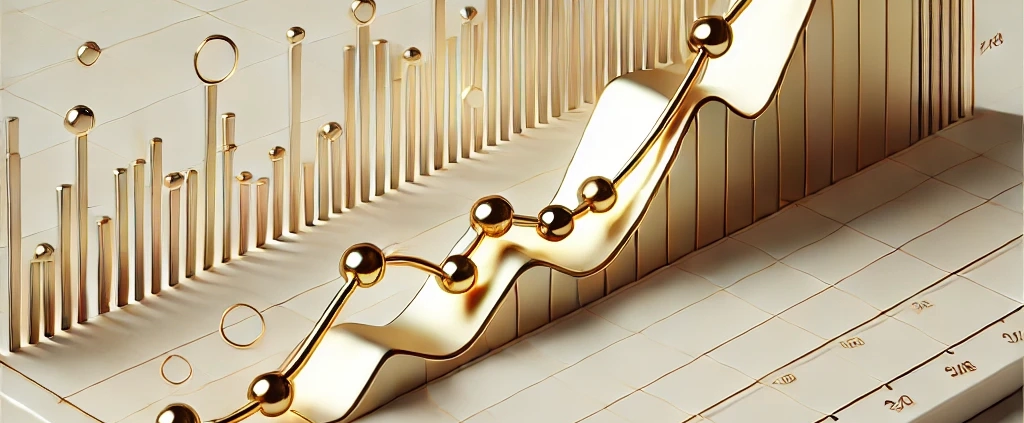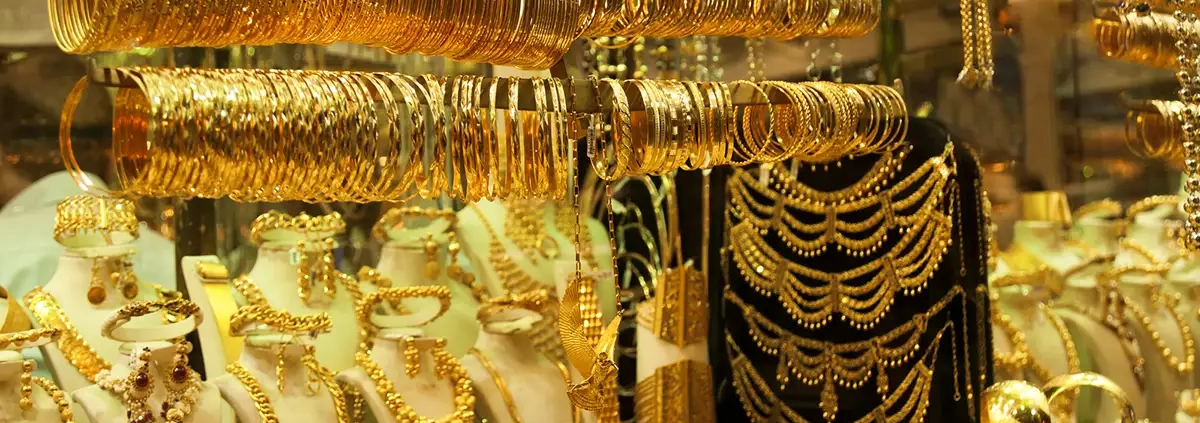We have received your message. If you indicated that you would like to make an appointment, we will reach out to you shortly.
When you sell gold to us, we will explain every step of the process to help you understand how selling gold works. With your XRF Precious metals Analyzer, we can test your gold to know exactly what purity your gold contains. This helps us assess your gold to give you the most when you sell.
Gold has always been a cornerstone of financial stability, serving as a hedge against inflation and economic uncertainty. As we look toward 2025, analysts predict a promising outlook for gold prices, supported by several macroeconomic and geopolitical factors. Here’s a comprehensive view of where experts expect gold prices to land in 2025.
Gold Price Predictions for 2025
1. J.P. Morgan: $2,600/oz
According to J.P. Morgan, gold prices are set to average $2,600 per ounce by the end of 2025. The projection is based on strong structural drivers, including central bank diversification away from the U.S. dollar and geopolitical tensions. With the Federal Reserve expected to lower interest rates, the case for gold as a hedge against inflation and currency devaluation remains robust. (Source: J.P. Morgan Chase)
2. ANZ Research: $2,805/oz
ANZ Research offers an even more optimistic outlook, forecasting an average price of $2,805 per ounce in 2025. This upward revision reflects the increasing demand for gold as a safe-haven asset amid global economic challenges. (Source: Techopedia)
3. Trading Economics: $2,700+/oz
Trading Economics predicts gold prices could reach $2,711 per ounce in early 2025, continuing a bullish trajectory fueled by rising inflation and monetary easing policies. As central banks globally look to loosen their monetary stances, gold is expected to benefit significantly. (Source: Techopedia)
4. Wider Predictions: $2,300–$3,300/oz
Some analysts, like Wahyu Laksono of Traderindo, foresee a broader trading range of $2,300 to $3,300 per ounce for gold in 2025. This variation accounts for potential spikes driven by heightened geopolitical risks, such as ongoing tensions in the Middle East, Ukraine, and Asia. (Source: Techopedia)
1. Geopolitical Uncertainty
The persistent conflicts in Ukraine, the Middle East, and Asia are expected to sustain high demand for gold as a safe-haven asset. Rising tensions between China and Taiwan, for instance, could further elevate gold prices.
2. Central Bank Purchases
Global central banks continue to add gold to their reserves, a trend that has significantly supported prices in recent years. This reflects a growing shift toward asset diversification away from the U.S. dollar.
3. Inflation and Monetary Policy
Inflation expectations are a key driver for gold prices. As central banks, including the Federal Reserve, consider rate cuts in 2024 and beyond, gold is positioned to benefit from a declining real yield environment.
4. Weakening U.S. Dollar
A softer dollar makes gold more appealing to international investors. Analysts highlight that as the dollar weakens, gold typically gains strength, adding to its appeal.
What This Means for Investors
For investors, 2025 could present significant opportunities to capitalize on gold’s bullish momentum. Analysts agree that structural factors, including inflation hedging, geopolitical tensions, and monetary easing, make gold a reliable store of value in uncertain times.
When to Buy?
While timing the market is always challenging, periods of price retracement in late 2024 or early 2025 may offer ideal entry points for long-term investors. Diversifying portfolios with gold could provide stability in the face of fluctuating economic conditions
Conclusion
Analysts foresee a bright future for gold prices in 2025, with forecasts ranging from $2,300 to $3,300 per ounce. As global uncertainties persist and inflation remains a concern, gold continues to shine as a critical asset in investment portfolios. Whether you’re a seasoned investor or new to precious metals, 2025 may be an opportune time to consider increasing exposure to gold.
Stay informed and prepared to make the most of these market insights as we approach what could be another golden year for gold!
Related Resources
China is one of the largest gold consumers and producers in the world. Chinese gold sometimes seems as if it’s more expensive than gold that comes from other countries. However, the reason that Chinese gold seems so expensive right now is that the world’s gold supply is low, and Chinese gold is often 24 karats (pure gold).
If you happen to own Chinese Gold jewelry and you need to turn that gold into cash, you might wonder, “Where can I sell my Chinese gold jewelry?” If you find yourself asking this question, you’re not alone. Many buyers wonder where they can turn to get the best value when selling their gold jewelry from China.
The truth is that selling gold from China is pretty straightforward. But understanding the right place to sell and what to expect can help you get the best return on your investment.
What is Chinese Gold?
Chinese gold is simply gold that comes from China. While all gold is the same on a molecular level, no matter where it comes from, gold from China is sometimes considered more valuable in the eyes of collectors and investors alike. China notoriously has a very high standard for gold which can make it a much sought-after commodity. Chinese gold jewelry, ornament and gold statues are generally 24K pure gold. Pure gold is very bright, soft and will never rust or tarnish. The gold is often times marked “999”, “9999” or “999.5”. Gold from China may also be marked with Chinese characters.
The Chinese culture has a very long history with gold, and the importance that the China places on gold plays a big part in why Chinese gold has such a high standard of purity. In Chinese culture, gold represents wealth, power, longevity, and happiness. Gold is often considered to be one of the most valuable and significant gifts one can give. This is why it’s often given at important life events such as birthdays, weddings, childbirth, and the New Year. Many people get Chinese gold as a gift or purchase it in China or Hong Kong without actually realizing its true value.
However, the value of your gold will depend on additional factors beyond purity levels. These other factors include both current market prices and buyer demand.
It’s a good idea to check the current spot price of gold as a starting point. The spot price is the current market price for gold per ounce and will give you an idea of its base value. Reputable buyers, such as precious metals dealers, will use this rate as a benchmark to calculate their offers.
How to Sell Your Chinese Gold Jewelry
So back to the question we’re here to answer: “Where can I sell my Chinese gold jewelry?” You have several types of buyers to choose from when it comes to selling your gold, so it’s crucial to choose a safe, trustworthy location. Here are some options you may consider:
Precious Metals Dealers
Specialized precious metals dealers, like California Gold & Silver Exchange, are some of the most reliable places to sell your Chinese gold. Here’s why:
- Expertise. Precious metals dealers have in-depth knowledge of the gold market and provide accurate appraisals based on the weight, purity, and current spot price of your gold.
- Competitive Offers. Established dealers generally offer competitive rates, especially for investment-grade gold.
- Immediate Payment. Dealers often offer on-the-spot payment through cash or check, making it a quick and convenient process.
Jewelry Stores
Some jewelry stores may buy gold, but they often specialize in jewelry rather than gold bars or coins. Their offers may be based more on the weight and purity without considering the investment-grade value.
If you’re considering this route, it’s wise to check reviews and confirm that they buy investment-grade gold.
Pawn Shops
While convenient, pawn shops may not offer the best rates for gold bars or coins. Their expertise is generally broader and less focused on precious metals, and this can lead to lower offers compared to those from precious metals dealers.
Additionally, pawn shops are likely to focus more on weight than on the investment value of the gold.
Online Marketplaces
Online marketplaces like eBay and Craigslist allow you to list your gold for a potential sale, But there are risks to keep in mind, including the following:
- No Guaranteed Buyer. Sales on these platforms can be unpredictable and might not secure the best price.
- Safety Risks. Shipping high-value items, like gold, involves risks of loss or theft.
- Transaction Fees. Selling through some online marketplaces may involve fees, reducing your final payout.
Selling gold in person to a reputable dealer, such as California Gold & Silver Exchange, eliminates these uncertainties and allows you to receive payment immediately without any associated transaction fees.
What to Expect When Selling Your Gold Jewelry to California Gold & Silver Exchange
When you bring your gold to California Gold & Silver Exchange, you can expect a straightforward, transparent evaluation process. Here’s how it works:
- Assessment. A professional will assess your gold based on weight, purity, and current market rates.
- Offer Based on Market Value. We make our offers based on the current spot price of gold, ensuring you receive a fair and competitive price.
- Immediate Payment. If you choose to sell, you’ll receive payment on the spot, with options for cash or check.
Selling gold to California Gold & Silver Exchange is easy. You’ll experience a clear, honest process with no hidden fees. Our priority is your peace of mind and confidence throughout the transaction.
Tips for Getting the Most Value
Here are some tips to keep in mind so that you get the most value out of the gold you’re selling:
- Know the Spot Price. Before selling, check the current spot price of gold. Being informed helps you evaluate offers more accurately.
- Bring Documentation. If you still have purchase documentation from China, it can be helpful to confirm the weight and purity of your gold. However, most reputable dealers can authenticate these details on-site.
- Consider Multiple Quotes. If you’re new to selling gold, consider getting quotes from different buyers. This helps you understand the going rate and choose the best offer.
Why Choose California Gold & Silver Exchange?
California Gold & Silver Exchange offers a friendly, professional environment, making it easy to sell the Chinese Gold securely and efficiently. With expert staff, competitive offers, and a transparent process, we ensure a satisfying selling experience.
Contact us today to learn more about selling your gold, or stop by our location to get a free, no-obligation quote.
Call (909) 985-4653 for current pricing or to schedule an appointment for a personalized consultation. Or click here for our address and hours.
Let us help you turn your Chinese gold jewelry or bullion into cash with confidence.
Buying gold from Costco has become a popular investment option, as the retailer offers quality gold bars and coins at competitive prices, but when you need to turn that gold into cash you might wonder, “Where can I sell my gold that I bought from Costco?”
If you find yourself asking this question, you’re not alone. Many buyers wonder where they can turn to get the best value.
The truth is that selling gold you purchased from Costco is actually straightforward. But understanding the right place to sell and what to expect can help you get the best return on your investment.
Understanding the Value of Your Gold from Costco
Costco offers a range of gold items, including bars and coins. They’re often sourced from reputable mints and designed to meet high standards of purity and quality. These products generally have similar purity levels to other investment-grade gold, meaning they contain 99.9% pure gold.
However, the value of your gold will depend on additional factors beyond purity levels. These other factors include both current market prices and buyer demand.
It’s a good idea to check the current spot price of gold as a starting point. The spot price is the current market price for gold per ounce and will give you an idea of its base value. Reputable buyers, such as precious metals dealers, will use this rate as a benchmark to calculate their offers.
Where to Sell Your Gold
So back to the question we’re here to answer: “Where can I sell my gold that I bought from Costco?” You have several types of buyers to choose from when it comes to selling your gold, so it’s crucial to choose a safe, trustworthy location. Here are some options you may consider:
Precious Metals Dealers
Specialized precious metals dealers, like California Gold & Silver Exchange, are some of the most reliable places to sell your Costco gold. Here’s why:
- Expertise. Precious metals dealers have in-depth knowledge of the gold market and provide accurate appraisals based on the weight, purity, and current spot price of your gold.
- Competitive Offers. Established dealers generally offer competitive rates, especially for investment-grade gold.
- Immediate Payment. Dealers often offer on-the-spot payment through cash or check, making it a quick and convenient process.
Jewelry Stores
Some jewelry stores may buy gold, but they often specialize in jewelry rather than gold bars or coins. Their offers may be based more on the weight and purity without considering the investment-grade value.
If you’re considering this route, it’s wise to check reviews and confirm that they buy investment-grade gold.
Pawn Shops
While convenient, pawn shops may not offer the best rates for gold bars or coins. Their expertise is generally broader and less focused on precious metals, and this can lead to lower offers compared to those from precious metals dealers.
Additionally, pawn shops are likely to focus more on weight than on the investment value of the gold.
Online Marketplaces
Online marketplaces like eBay and Craigslist allow you to list your gold for a potential sale, But there are risks to keep in mind, including the following:
- No Guaranteed Buyer. Sales on these platforms can be unpredictable and might not secure the best price.
- Safety Risks. Shipping high-value items, like gold, involves risks of loss or theft.
- Transaction Fees. Selling through some online marketplaces may involve fees, reducing your final payout.
Selling gold in person to a reputable dealer, such as California Gold & Silver Exchange, eliminates these uncertainties and allows you to receive payment immediately without any associated transaction fees.
What to Expect When Selling Your Gold to California Gold & Silver Exchange
When you bring your gold to California Gold & Silver Exchange, you can expect a straightforward, transparent evaluation process. Here’s how it works:
- Assessment. A professional will assess your gold based on weight, purity, and current market rates.
- Offer Based on Market Value. We make our offers based on the current spot price of gold, ensuring you receive a fair and competitive price.
- Immediate Payment. If you choose to sell, you’ll receive payment on the spot, with options for cash or check.
Selling gold to California Gold & Silver Exchange is easy. You’ll experience a clear, honest process with no hidden fees. Our priority is your peace of mind and confidence throughout the transaction.
Tips for Getting the Most Value
Here are some tips to keep in mind so that you get the most value out of the gold you’re selling:
- Know the Spot Price. Before selling, check the current spot price of gold. Being informed helps you evaluate offers more accurately.
- Bring Documentation. If you still have purchase documentation from Costco, it can be helpful to confirm the weight and purity of your gold. However, most reputable dealers can authenticate these details on-site.
- Consider Multiple Quotes. If you’re new to selling gold, consider getting quotes from different buyers. This helps you understand the going rate and choose the best offer.
Why Choose California Gold & Silver Exchange?
California Gold & Silver Exchange offers a friendly, professional environment, making it easy to sell the gold you bought from Costco securely and efficiently. With expert staff, competitive offers, and a transparent process, we ensure a satisfying selling experience.
Contact us today to learn more about selling your gold, or stop by our location to get a free, no-obligation quote.
Call (909) 985-4653 for current pricing or to schedule an appointment for a personalized consultation. Or click here for our address and hours.
Let us help you turn your Costco gold into cash with confidence.









